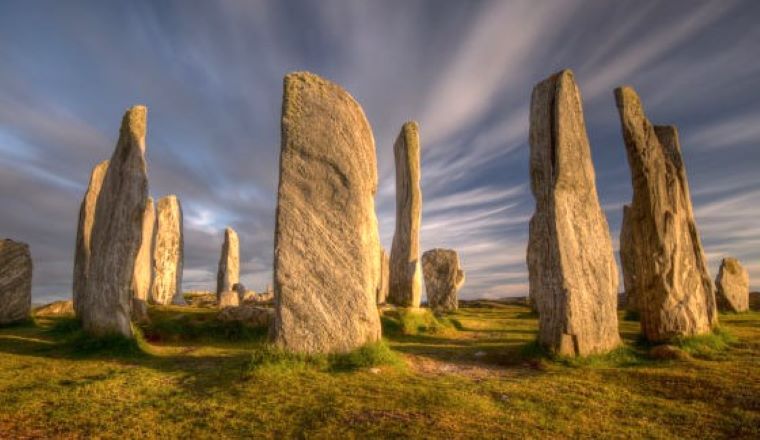
Place has always been important to the Celts. In fact, the earliest linguistic information we have for the Celtic peoples records how important the land was to them. The river Seine was named for the goddess Sequana who, like the Boyne in Ireland, was simultaneously the river itself, the goddess, and the ancestral progenitrix of her people. A statue to her still stands in the grotto at St. Germaine where the river springs from the earth. The Danube is thought to derive its name from a similar goddess who might have given her name to the Tuatha Dé Danann of Ireland. Stories from the early medieval period record narratives that are written literally into the landscape. Scéla Muicce Meic Dá Thó – “The Story of Mac Dá Thó’s Pig” – explains how the monstrous hound Ailbe gave his name to various fords and hills when he was killed in a dispute between Ulster and Connacht over the titular hound, just as the famous Táin Bó Cuailgne, “The Cattle Raid of Cooley,” shows how two bulls, the Finnbennach of Connacht and the Donn Cuailgne of Ulster, met their end and mapped their stories onto the landscape.
No less important was travel, though it was different from the broader European culture of pilgrimage which eventually came to eclipse it. One of the seven tale-types of medieval Irish literature was the imram, literally “a rowing” or wandering. These seem to have been stories in which the protagonist travels from home to strange and distant lands, encountering wonders and adventures of different kinds. The best example is Imram Brain Maic Febail – “The Wandering of Bran” – in which Bran travels the ocean, meets significant otherworldly figures like Manannan mac Lír and disappears from mundane life. Such imrama like this and the voyages of Mael Dúin and Brendan are probably part of a wider tradition of eachtraí or ‘adventures’ in which the protagonist travels to the otherworld, encountering unimaginable strangenesses. In the Eachtra Néra for example, Néra travels into one of the sídh, the ancient burial mounds, to find an otherworldly crown hidden in a well and watched over by a lame man carried by a blind man.
 The common theme here is that such journeys away from the normalcy of home bring the journeyers into direct contact with the ancient and supernatural powers that underpin reality itself.
The common theme here is that such journeys away from the normalcy of home bring the journeyers into direct contact with the ancient and supernatural powers that underpin reality itself.
Such journeys could be considered a kind of pilgrimage which, during the twelfth century, was becoming big business in Europe as believers could atone for wrongdoing by hazarding a journey to visit the relics of saints. Held in cathedrals and churches across Europe, these relics were considered to carry the power of the saint to bless and heal, and – as pilgrimage became increasingly used as a punishment for secular crimes – an industry of pilgrimage began to form around it. Sacred architecture adapted to the throngs of travelers who sought visitation with relics no matter the time or religious observations. Aisles and ambulatories were added to accommodate pilgrims without disrupting the religious rhythm of worship, and specially designated taverns and hostelries sprang up all along the roads that came to be known as pilgrim routes. Thus, while religious pilgrims across Europe were engaged in an institutionally authorized practice – and as the Celts of the Atlantic Fringe looked to imrama and eachtraí as spontaneous engagement with spiritual realities living within and beyond the land itself – both were traveling from the habitual world of the settled present into unfamiliar and strange lands to gain the supernal and transcendent benefits of the supernatural.
The land is no less sacred to us today. In the wake of the Celtic Diasporas of the seventeenth, eighteenth and nineteenth centuries, those of us in North America look back to Europe as a place – like the otherworldly island of the Welsh poem Preiddeu Annwfn where King Arthur won the cauldron of inspiration from its nine maiden protectors – across the sea and imbued with an ancient power beyond our normal experience. Of course, for us this experience is attached not to living magic but ruins, music, language, and, of course, the stories that still inform the land itself.
In the spring of 2015, I travelled with my children to the marches of Wales where, according to legend, the Celtic leader, Caractacus, once battled against the Romans. Near a little town called Church Stretton stands a long hill, bare and crested with strange stones that are said to be the fingertips of the giant that sleeps beneath its precipitous slopes. At the north end stands a crag where Caractacus was said to have held a last defence against the Romans. Now named Caer Caradog, this hill still carries the force of this legend as a testament to the power of place, the past, and our pilgrimages. Like the giant, the stories we tell informing such places sleep just beneath the surface, showing us the barest tips of their full glory and strangeness.
All we need to do is step on the road.
~ James Acken
www.ackenstudios.com




















Leave a Comment